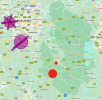Hello! I am new to this forum and I am looking for some advice and opinions from experienced UK flyers.
I have been thinking about buying the Mini 3 Pro to take pictures of pretty and/or dramatic places in the UK. I do not yet own a drone (although I used one with a very short flight time for fun about 10 years ago) but I have been reading about the drone code, CAA requirements, operational categories and so on. Having read lots of the available information online it seems the places you can legally fly such a drone in the UK are very limited (despite the model being below 250g).
For example, I live close to the Peak District national park but that has by-laws that say you cannot fly from Peak District land or even over it (unless it’s a privately owned part of the park and the land owner has given permission). According to their web sites, most of the other national parks in the UK have the same policies or by-laws as the Peak District.
So my questions are… Is it worth the investment in a drone to take pictures of pretty places in the UK when I am likely to find I have very few such places to legally fly it? Am I correct in my conclusion that there are few places? Also, I think it might help me to make a decision if people say how they find legal places to photograph or film by drone in the UK.
I have been thinking about buying the Mini 3 Pro to take pictures of pretty and/or dramatic places in the UK. I do not yet own a drone (although I used one with a very short flight time for fun about 10 years ago) but I have been reading about the drone code, CAA requirements, operational categories and so on. Having read lots of the available information online it seems the places you can legally fly such a drone in the UK are very limited (despite the model being below 250g).
For example, I live close to the Peak District national park but that has by-laws that say you cannot fly from Peak District land or even over it (unless it’s a privately owned part of the park and the land owner has given permission). According to their web sites, most of the other national parks in the UK have the same policies or by-laws as the Peak District.
So my questions are… Is it worth the investment in a drone to take pictures of pretty places in the UK when I am likely to find I have very few such places to legally fly it? Am I correct in my conclusion that there are few places? Also, I think it might help me to make a decision if people say how they find legal places to photograph or film by drone in the UK.












